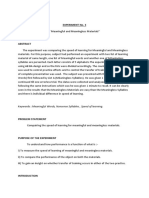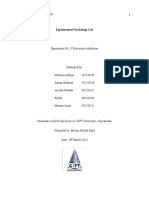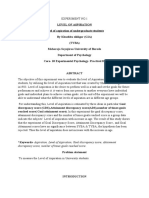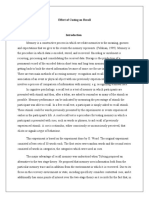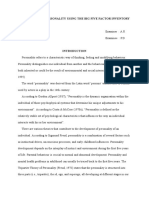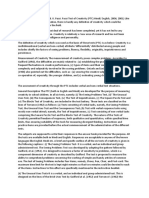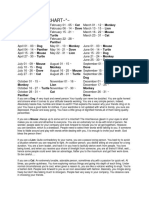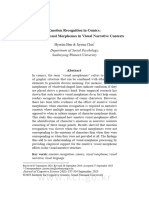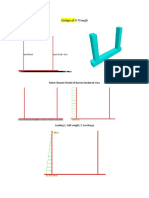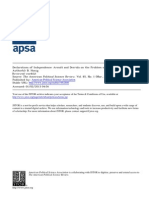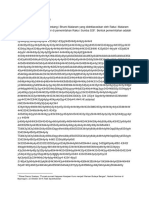Bilateral Transfer
Bilateral Transfer
Uploaded by
Akhil VrCopyright:
Available Formats
Bilateral Transfer
Bilateral Transfer
Uploaded by
Akhil VrOriginal Title
Copyright
Available Formats
Share this document
Did you find this document useful?
Is this content inappropriate?
Copyright:
Available Formats
Bilateral Transfer
Bilateral Transfer
Uploaded by
Akhil VrCopyright:
Available Formats
BILATERAL TRANSFER
PROBLEM
To determine the phenomenon of bilateral transfer before and after design.
INTRODUCTION
The effect of fast learning or new learning is designated as transfer of learning. It can also use
to our attention and concentration problems. According to Hilgard the influence that learning of
performance of performance of another task is called transfer of learning is one of the most
pervasive characteristic of behavior. This guaranties the continuity and lawful development of
habits of ever growing complexities. The effect of past learning or new learning may be
classified in one of the three categories, positive transfer occur when past experience facilitate
the acquisition of a new skill or solution of a new problem. Negative transfer occurs when past
experience render more difficult or shows down the acquisition of a new skill or the solution of a
new problem.
Crosse education refers to the facilitation of performance with one part of the body. When
Crosse education is from one body organ to its symmetrical counterpart it is called as bilateral
transfer. It is usually demonstrated by mirror drawing board. Stach (1910) was first to apply
mirror drawing method on the study of bilateral transfer. Studies conclude that bilateral transfer
is a form of positive transfer where the subjects do better after training.
METHOD
Subject
Name
Age
Sex
MATERIALS
Mirror drawing board
Stylus
Stop Watch
PROCEDURE
The mirror drawing apparatus is connected with a stylus in such a way that whenever the
stylus touches on either side of the groups of the star pattern, the circuit is completed and hence
an error is detected. Subject is placed in front of the apparatus and the screen of the apparatus is
arranged in such a way that the star pattern can see only through the mirror and that the screen
does not block the movement of the hand. Conduct the experiment on two series.
A) Left hand before training (Non Preferred hand)
Instruct the subject as follows when a star you look at the left reflection in the mirror and try star
pattern by moving the stylus along the grooves from end points and reach the original point in
anticlockwise direction . Trace as quickly as possible without touching. The error will be
recorded whenever you touch the side of the grooves with the stylus. Performance will be timed
with the above instruction, asks the subject to trace the pattern with the left hand. Note down the
time taken and errors committed
Then give the subjects to 10 trials to trace the star pattern with the preferred hand in clockwise
direction. Note down the time taken and errors committed in each trial.
B) Left hand after training (Non Preferred hand)
Following the same procedure ask subject to trace the star pattern with the left hand once
again in the clockwise direction then note the time taken and errors committed.
PRECUATION
Do not allow the subject to see the star pattern directly while tracing.
Instruct the subject to work as rapidly as possible.
RESULT
Table 1
Errors committed and time taken by the subject to trace star pattern
Before training Practiced trials with preferred hand After training
non preferred non preferred
hand hand
1 2 3 4 5 6 7 8 9 10
Time taken
in seconds
Errors
Mean time taken for the subject for the first 3 practice trials =
Mean Error committed by the subject for first 3 practice trials=
Mean time taken for the subject for the last 3 practice trials =
Mean error committed by the subject for last 3 practice trials=
DISCUSSION
CONCLUSION
REFERENCE
Chaube, S.R.(1985).Experimental Psychology. Agra; Lakshmi Narayan publications.
You might also like
- Practical 2 Muller - Lyer IllusionDocument8 pagesPractical 2 Muller - Lyer IllusionSehaj Bedi50% (2)
- Level of AspirationDocument13 pagesLevel of AspirationShivani Marathe86% (7)
- Experiment 3Document9 pagesExperiment 3Kenny Gurumayun100% (3)
- Experiment No.1 Span of AttentionDocument8 pagesExperiment No.1 Span of AttentionMuskan Sukheja100% (7)
- Bilateral Transfer LabDocument11 pagesBilateral Transfer Labnixon100% (1)
- Practical 3 Concept Formation: PurposeDocument9 pagesPractical 3 Concept Formation: PurposeSehaj Bedi100% (5)
- Retroactive Inhibition FDocument13 pagesRetroactive Inhibition FHamd Shahzad100% (1)
- Locus of ControlDocument5 pagesLocus of ControlArpit Kumar100% (1)
- Bilateral Transfer of LearningDocument12 pagesBilateral Transfer of LearningTanya Kim Mehra100% (1)
- Experiment No. 1 Whole vs. Part Method of Learning Key Words: Learning, Memory, Whole Method of Learning, Part Method of Learning. Problem StatementDocument7 pagesExperiment No. 1 Whole vs. Part Method of Learning Key Words: Learning, Memory, Whole Method of Learning, Part Method of Learning. Problem StatementEthel LunguNo ratings yet
- 3 Habit InterferenceDocument7 pages3 Habit InterferenceMeenu S Babu 193743389% (9)
- Zeigarnik Effect 1Document8 pagesZeigarnik Effect 1Ammara Haq100% (3)
- Muller Lyer Experiment Method AimDocument3 pagesMuller Lyer Experiment Method AimNikhil LatawaNo ratings yet
- Bhatia 1Document4 pagesBhatia 1Eswar Naveen50% (2)
- Experiment 4: Social Maturity ScaleDocument21 pagesExperiment 4: Social Maturity ScaleMansi AgarwalNo ratings yet
- 9 Bhatia Battery Performance TestDocument16 pages9 Bhatia Battery Performance Testshashank aggarwalNo ratings yet
- Bilateral Transfer of LearningDocument8 pagesBilateral Transfer of Learningarunsangeeta67% (6)
- Knowledge of Results Experimental PsychologyDocument12 pagesKnowledge of Results Experimental Psychologysvavidhya library100% (2)
- Practical No. 4 - Maze Learning: ObjectiveDocument4 pagesPractical No. 4 - Maze Learning: ObjectiveNupur Pharaskhanewala100% (2)
- Practical No. 4 - MIRROR DRAWING: ObjectiveDocument4 pagesPractical No. 4 - MIRROR DRAWING: ObjectiveNupur Pharaskhanewala0% (1)
- Knowledge of ResultsDocument9 pagesKnowledge of ResultsnatashasenoberoiNo ratings yet
- Habit Interference: Athulya, Anu, Mahreen, Medhavi, Sandhya, Sanjana, Sunethra, VaishaliDocument17 pagesHabit Interference: Athulya, Anu, Mahreen, Medhavi, Sandhya, Sanjana, Sunethra, VaishaliSanjana Vijaynidhi 18PJW04350% (2)
- Maze LearningDocument10 pagesMaze LearningSHUMRITHI100% (1)
- Human Maze Learning 1Document6 pagesHuman Maze Learning 1Bilal PervaizNo ratings yet
- Memory Span ExperimentDocument10 pagesMemory Span ExperimentKP Gunio100% (2)
- Level of Aspiration Experiment 01 - Khushbu SikligarDocument27 pagesLevel of Aspiration Experiment 01 - Khushbu SikligarKhushbu Sikligar100% (3)
- Tweezer Dexterity by Saima KhanDocument6 pagesTweezer Dexterity by Saima KhanHmm OkNo ratings yet
- Span of Attention ManualDocument5 pagesSpan of Attention Manualliya shanawasNo ratings yet
- 1 Effect of Cueing On RecallDocument7 pages1 Effect of Cueing On RecallMeenu S Babu 1937433100% (2)
- Interest: Meaning, Types and Measurement - PsychologyDocument6 pagesInterest: Meaning, Types and Measurement - Psychologypadmaja100% (2)
- Sentence Completion Test - Practical FinalDocument8 pagesSentence Completion Test - Practical FinalPradipto Chakrabarty100% (1)
- Pass Along TestDocument4 pagesPass Along TestNupur Pharaskhanewala83% (6)
- Trial and Error Theory by ThorndikeDocument5 pagesTrial and Error Theory by Thorndikemaddy mahiNo ratings yet
- Practigal-4: Judgin G Bmotion B Y PhotographsDocument12 pagesPractigal-4: Judgin G Bmotion B Y PhotographsBhavya RathoreNo ratings yet
- Muller IllusionDocument6 pagesMuller IllusionAkanksha SridharNo ratings yet
- Mapping of Retinal Colour ZonesDocument5 pagesMapping of Retinal Colour Zonesliya shanawas100% (1)
- Trial and Error LearningDocument12 pagesTrial and Error LearningFathima Thabsheera100% (1)
- Span of AttentionDocument4 pagesSpan of AttentionDeepak Saini100% (3)
- Massed VS Spaced Practice of Learning...Document14 pagesMassed VS Spaced Practice of Learning...Snow White0% (1)
- Division of AttentionDocument4 pagesDivision of AttentionAmisha Makwana100% (4)
- BFFIDocument11 pagesBFFIAkshaya S100% (1)
- EXPERIMENT 02 - Span of AttentionDocument14 pagesEXPERIMENT 02 - Span of AttentionKhushbu Sikligar86% (7)
- S M Mohsin's Intelligence TestDocument3 pagesS M Mohsin's Intelligence TestNashrah Iman100% (1)
- Muller LyerDocument12 pagesMuller LyerMeenu S Babu 1937433100% (7)
- Rosenzweig Picture Frustration Indian AdaptationDocument7 pagesRosenzweig Picture Frustration Indian Adaptationprerna9486100% (1)
- Experiment No 2 Flactuation of Attention ProblemDocument4 pagesExperiment No 2 Flactuation of Attention ProblemNouman100% (2)
- Bhatia Battery TestDocument5 pagesBhatia Battery TestAkshita Singh100% (1)
- Retroactive Inhibition. Exp6Document4 pagesRetroactive Inhibition. Exp6liya shanawas100% (3)
- 2 Paired Associate LearningDocument11 pages2 Paired Associate LearningMeenu S Babu 1937433100% (2)
- Experiment - Bilateral Transfer of TrainingDocument20 pagesExperiment - Bilateral Transfer of TrainingTanya Kim Mehra100% (1)
- Passi's Test of CreativityDocument5 pagesPassi's Test of CreativityNupur Pharaskhanewala100% (3)
- CIS PracticalDocument10 pagesCIS Practicalaysha fariha100% (1)
- Amity University, Mumbai Aibas: Title: Eysenck's Personality InventoryDocument9 pagesAmity University, Mumbai Aibas: Title: Eysenck's Personality Inventorykaashvi dubey100% (1)
- Knox Cube TestDocument3 pagesKnox Cube Testpriyanshi khandelwal100% (2)
- Muller Lyer IllusionDocument7 pagesMuller Lyer IllusionAoun AliNo ratings yet
- Test of IntelligenceDocument8 pagesTest of IntelligenceChava Rohan VasudevaNo ratings yet
- Experiment Bilateral Transfer - Google DriveDocument8 pagesExperiment Bilateral Transfer - Google Drive5472853.09.pranatiNo ratings yet
- bilateral transfer of training(1)Document2 pagesbilateral transfer of training(1)wahabNo ratings yet
- Bilateral Transfer PSYDocument5 pagesBilateral Transfer PSYliya shanawasNo ratings yet
- Quantum Electrodynamcs: November 8, 2017Document125 pagesQuantum Electrodynamcs: November 8, 2017Cosmin IstrateNo ratings yet
- HSE PRESENTATION On ErgonomicsDocument98 pagesHSE PRESENTATION On ErgonomicsOnyema Emmanuel100% (1)
- Birthday Chart : Mouse Lion Turtle PantherDocument2 pagesBirthday Chart : Mouse Lion Turtle PantherAparnaNo ratings yet
- Erapol E90A: Technical DatasheetDocument2 pagesErapol E90A: Technical Datasheetmgamal1080No ratings yet
- MAY-JUNE IGCSE and A Level Edexcel & Cambridge EXAM TIMETABLEDocument1 pageMAY-JUNE IGCSE and A Level Edexcel & Cambridge EXAM TIMETABLESulaiman EssamNo ratings yet
- Emotion Recognition in Comics: The Effect of Visual Morphemes in Visual Narrative ContextsDocument18 pagesEmotion Recognition in Comics: The Effect of Visual Morphemes in Visual Narrative ContextsJiyung ByunNo ratings yet
- Design of U Trough: Finite Element Model of Barrel Rendered ViewDocument6 pagesDesign of U Trough: Finite Element Model of Barrel Rendered ViewIgnatius PathulaNo ratings yet
- HR Strategy of Infosys LimitedDocument11 pagesHR Strategy of Infosys LimitedshamitasathishNo ratings yet
- Io Twith SarikaDocument9 pagesIo Twith SarikaMohammad HossainNo ratings yet
- Bhrigu Samhita IntroductionDocument2 pagesBhrigu Samhita IntroductionpjpropraveenssNo ratings yet
- Mims PR2 LC1 Quantitative ResearchDocument11 pagesMims PR2 LC1 Quantitative ResearchJester Guballa de LeonNo ratings yet
- Lesson Plan-Math-Bulan, ShennaDocument5 pagesLesson Plan-Math-Bulan, ShennaPATRICIA VISDA ASTORNo ratings yet
- Declarations of Independence Arendt and Derrida On The Problem of Founding A Republic - HonigDocument18 pagesDeclarations of Independence Arendt and Derrida On The Problem of Founding A Republic - HonigIntinion ClowngottesNo ratings yet
- Field Visit Report: Samohita Das Bsc-15-34 BSC Psychology 3 Year Psychopathology-Ii MSSWDocument10 pagesField Visit Report: Samohita Das Bsc-15-34 BSC Psychology 3 Year Psychopathology-Ii MSSWpreethikaNo ratings yet
- Mataram MedangDocument7 pagesMataram MedangAgustinus SiswantoNo ratings yet
- Plugging and Abandonment of Oil and Gas Wells: Paper #2-25Document21 pagesPlugging and Abandonment of Oil and Gas Wells: Paper #2-25Fabian MontoyaNo ratings yet
- Vytalyze CBD Oil Where To Buy, Read Price, Reviews & Scam!Document3 pagesVytalyze CBD Oil Where To Buy, Read Price, Reviews & Scam!muriellearrNo ratings yet
- Idioms SlangsDocument6 pagesIdioms SlangsTeacher 1No ratings yet
- OSCPDocument86 pagesOSCPabhilashchris63No ratings yet
- Scope of Professional PracticeDocument11 pagesScope of Professional PracticeJulia Stefanel PerezNo ratings yet
- Hand MirrorDocument17 pagesHand Mirrorwilmer caspa carrascoNo ratings yet
- Personal Balanced Scorecard TemplatesDocument4 pagesPersonal Balanced Scorecard Templatesj.faraone21No ratings yet
- Consumer BehaviourDocument20 pagesConsumer BehaviourKhyati BadariaNo ratings yet
- INTEGERSDocument5 pagesINTEGERSBireshwar DasNo ratings yet
- 109-8833 CYLINDER GP. - TILT 844 : 844H : 844K : D9R : D9T CAT 110-3269 CYLINDER GP. - LIFTDocument14 pages109-8833 CYLINDER GP. - TILT 844 : 844H : 844K : D9R : D9T CAT 110-3269 CYLINDER GP. - LIFTMuvuma JordanNo ratings yet
- Magnus Credit Card For Burgundy FaqDocument20 pagesMagnus Credit Card For Burgundy FaqsaltstewieNo ratings yet
- D5M/D6M Track-Type Tract ORSDocument34 pagesD5M/D6M Track-Type Tract ORSELELCTRICAR SAS100% (3)
- Media Hand BookDocument36 pagesMedia Hand BookLynn ThetNo ratings yet
- Sin Sickness and SalvationDocument15 pagesSin Sickness and SalvationKidane HailuNo ratings yet
- Morpho Test 1Document2 pagesMorpho Test 1Phương VyNo ratings yet


